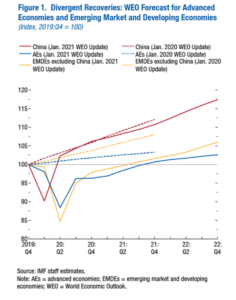Last month, the International Monetary Fund (IMF) released its 2021 global economic outlook predicting a global economic growth of 5.5 percent in 2021 and 3.5 percent in 2022. The IMF had revised the 2021 percentage to be 0.3 points higher than the previous forecast, reflecting the prospects of a vaccine-enabled higher economic activity.
“I believe that 2021 will also be a year like no other, but for different reasons. It will continue to be a race between vaccines and the virus,” said Gita Gopinath, the IMF’s chief economist on February 10 during a live conversation jointly hosted by the AUC School of Business and the IMF, moderated by economics graduating senior Nada Bakri, attended by Sherif Kamel, dean of the AUC School of Business, and a wide audience of webinar attendees and others following the talk on live social media streaming. Business Forward brings you the highlights of what Gopinath shared during the one-hour conversation covering the IMF outlook and some audience questions.
Growth in the aftermath of COVID-19
“2021 is a year where you will mechanically see eye-popping numbers on pretty much any variable you want to pick,” said Gopinath explaining that this is due to bounce back from the low 2020 figures, with the gradual reopening of economies. “Debt is at records high and global public debt is slightly higher than what we had in World War II,” she remarked. Together with high stimulus fiscal policies in advanced countries, the accelerating growth numbers are reflecting on the rest of the world too.
While traditionally during crises, stimulating policies were used, Gopinath explains, this time countries had to make a tricky balance between urging people to stay home and spend less, while also using monetary policy to “keep the fabric of the economy in place so that when we reopen people will return quickly to work, consumption and investment.”
Gopinath spoke about the trade-off between recovery and avoiding overvaluation of risky assets. “So, while you keep interest rates low and accommodative, you are not letting financial risks build up in the system because if anything goes wrong there will be problems in advanced economies, with spillover effects in developing ones.”
We should also consider that at some point governments could remove the exceptional policy measures that were put in place to respond to the crisis, like those related to loans and mortgages.
“We have to see how the world reacts at that point in time. We like the growth story, but we want to make this is sustainable, so doesn’t result in overheating or anything of that sort.”
She also agrees that monetary policy has been heavily used during this crisis, to the extent of getting close to the zero lower interest rate in some cases. “Let us hope that we will not be in a situation where we will need more monetary policy.”
On the fiscal front, countries will have “to continue to support their populations- at the minimum- through healthcare spending and cash transfers to the poor, depending on the amount of [the virus] containment measures,” Gopinath points, also adding that this is harder for less-developed countries that have a constrained fiscal space.
These countries will also feel pressure to spend on climate adaptation and expanding digital infrastructures. “We [the international community] need to make sure developing countries are able to do the right amount of investment to attain Sustainable Development Goals (SDGs) so that we continue to see convergence in prospects around the world.”
Divergence in growth rates
How much the past year affected an economy and hence its recovery depends on the severity with which the pandemic hit and how much contamination control measures had to be in place in the country. Some countries have managed to bring down the number of cases, and some are still subject to lockdown and the resulting prevention of certain kinds of economic activities.

The divergence that exists in the structures and nature of economies and how much policy space they enjoy, will also be reflected in their responses.
“Advanced economies were able to spend up to 24 percent of GDP in fiscal responses to the crisis, compared to only 6 percent in emerging and middle-incomes economies, and 2 percent in low-income ones,” points out Gopinath.
She goes further to explain how countries that had well-established digital infrastructures in place were able to respond better and faster with work-from-home measures and distance learning, and also in availing social protection transfers and managing more inclusive interventions, reaching out to vulnerable households and struggling firms.
Gopinath also notes that economies that heavily depend on contact-intensive sectors like hospitality and tourism were hit harder than those on technology-based sectors or financial services, in which remote working can be accommodated.
Regarding the emergence of vaccines and all the prospects this brings, Gopinath sees good news in the development of successful vaccines. However, she points out to a division – and possibly even inequality.
“Advanced countries have access to the vaccine and some have their own production, while many more countries do not have this access and are unlikely to get there until next year or even beyond that […] Everything has to be done to address that,” she says referring to further financing to make sure countries get the doses they need. She also advises looking into how to ensure enough production, especially with the possibility of needing updated vaccines to deal with new strains of the virus.
New priorities, old priorities
Gopinath discussed several persistent as well as rising policy priorities for countries to support their recoveries and address changing contexts related to the protracted pandemic situation, climate change pressures and changing labor markets.
Healthcare spending remains a priority, and now includes the cost of the vaccines roll-out, Gopinath believes. “Once we start seeing that contagion is under control, we will need to encourage labor to move to sectors that are growing. Allow for the resource reallocation to happen,” she recommends.
Climate change “is a huge existential threat to the planet” and has of course been a pressing concern before the crisis. Gopinath mentions that there is IMF research to indicate that synchronized green public investments by countries that can afford them will be good for the planet and could also create jobs.
As automation and shifts to more digitalized economies grow stronger, Gopinath warns of the inequalities that may arise. Targeted interventions are needed to ensure local populations in all parts of the country are well-informed and have access to good schools, and opportunities, as well as interventions to support population segments who “will not overnight have the needed skills” for a more automated economy.
The outlook is that the more mechanical the jobs, the easier they can be automated, as opposed to those with more creative components or with high human interaction. Hence, ensuring high levels of education, training and skilling are basic steps to make sure people can transition to the new forms of work. She also notes that public policy plays a role in how much and how fast an economy becomes automated; “so the right amount is an important question.”
Yet Gopinath also believes that building digital infrastructures, “is a low-hanging fruit for countries where there is not yet enough internet penetration.” This can be obtained through external financing or private investment, and it also makes a very valid case for development financing from the relevant institutions, she argued.
Another unique feature of the COVID-19 crisis is how the informal sector has been affected. In previous crises, the informal sector has been a shock-absorber, acting as a safety net, according to Gopinath, further adding that this time it has been hardly hit, calling for creative solutions by governments to get cash in the hands of the affected workers. With recovery and restoration of livelihoods and increasing in spending, jobs will return everywhere and that will reflect on the informal sector. She believes, however, that encouraging formalization is important to help raise both the productivity and protection of informal workers.
“The crisis has also made the importance of safety nets abundantly clear. Some countries will have to think how to have social safety nets in an extended form or more prolonged basis,” she emphasizes.
Looking from a gender lens
Gopinath also shares her take about the gender aspect of the pandemic crisis. While usually in recessions it is the manufacturing sectors that get the hardest hit, “the peculiarity of this crisis caused the services sector to be hit the hardest. It is in services where you have a greater share of working women.”
Being largely responsible for childcare in many parts of the world, women are the ones to have stayed home during school lockdown to take care of children, she clarifies. The challenge will be to make sure that with recovery, women are returning to the workforce. “I believe that the flexibility of work from home will make work more attractive and doable for women, and that is a favorable outcome.”
The IMF and Egypt
Gopinath commented on the IMF 2016-2019 economic reform program in Egypt, acknowledging the progress the country has made in implementing this program, managing to improve foreign reserves and build a much stronger macroeconomic environment, which has been a supporting factor in Egypt’s coping with the pandemic.
She also mentioned that the features of the current Stand-By Arrangement with Egypt and other countries include increasing the role of the private sector, improving governance, and enhancing inclusivity and social safety nets, and this is what is needed to move forward.
“This will put Egypt on a strong foot macroeconomically [while] also having sustainable and inclusive growth.” She further commented on Egypt’s management of the crisis, despite being hardly hit as a tourism-based economy, “it has actually managed the crisis better than others,” she said.
On a global level, “even though the second wave that hit the world was worse in terms of numbers, in terms of the hit to economic activity it was significantly smaller which tells us that the world has adapted.”
Watch the full webinar:









